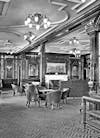It was a requisite room in the mansions and elegant dwellings of yesteryear, now reminiscent of a bygone era of club chairs, smoking jackets, and sparkling social lives : the smoking room.


It was a requisite room in the mansions and elegant dwellings of yesteryear, now reminiscent of a bygone era of club chairs, smoking jackets, and sparkling social lives : the smoking room.
Text : Valentin Goux
Photography : Gaspard Hermach/RINCK
A place of masculine sociability where the menfolk would meet after dinner to chat, while smoking cigars and sipping spirits. To the point of inspiring this passage from Henry Harvard in 1894 in his Dictionnaire de la Décoration et de l'Ameublement : “This is yet another of the many reasons the cigar is criticized – it separates the sexes, leading men to band together elsewhere, on their own, the moment dinner is over.”
Happily, times have changed. Today, be it due to shifting gender perceptions or evolving tobacco consumption, the smoking room has essentially merged with the living room and rare are rooms reserved exclusively for smoking. In an ironic tip of the hat, the smoking-room ensemble designed by Rinck for the Hébé collection, unveiled in January 2021, was crafted with distinctly feminine character, with many nods – via textiles and ornamentation – to the symbolic strength of powerful women, those who have neither need nor desire to apologize for talking loudly while drinking the whiskey once reserved for their grandfathers.
Let’s take a quick trip back in time. Tobacco arrived in Europe in the 16th century, became more prevalent in the 17th century, and its use continued to spread in the decades to follow. This is reflected in the opening of Molière’s 1665 five-act comedy, Dom Juan ou le Festin de Pierre, which includes this famed ode to tobacco by the character Sganarelle : “Let Aristotle and all the Philosophers in the World say what they will, nothing is like Tobacco ; ‘tis the Darling of all Men of Honor, and he that lives without tobacco is not worthy of Life. It not only gladdens and purges Man’s Brain, but likewise puts him in the way to Virtue, and one learns with it to become an honest Man.” We have come a long way from that perspective.
With the progressive specialization of rooms in the 18th century, the smoking room made its way into bourgeois homes in Paris and London. Thus the small conversation room and smoking room of French socialite Juliette Récamier at Rue de la Chaussée d’Antin, where leading literary and political personalities would gather. But it was under the next emperor that the fashion would spread to France, as it spread to Victorian England and the American mansions of the Gilded Age. It was a time of eclecticism ; smoking rooms were temples of exoticism, with décor inspired by Eastern lands and the imagined delights of those places, amidst colonial expansion. Napoléon III was a great tobacco lover, having been introduced to the vice in London clubs, and created smoking rooms at Compiègne and Fontainebleau. Not a single home of the haute bourgeoisie or aristocracy was without this fashionable space.
Early in the following century, the rise of Art Deco and the adventure of transatlantic liners would once again revive the smoking-room trend. The Roaring Twenties saw smoking rooms of incomparable sophistication, such as Jean Dunand’s lacquer smoking room for the Pavillon d'une Ambassade Française, at the 1925 Exposition Internationale des Arts Décoratifs et Industriels Modernes in Paris. Or the sublime smoking room by Lucie Renaudot featured in 1929 in the magazine Mobilier et Décoration. Or that of Ruhlmann for Monsieur Léon Dubly, which appeared in another well-known publication, L'Illustration, in May 1933. The masculine hallmarks of these spaces were often reinforced by the use of leather and dark wood. The games table also began appearing in the smoking room at this time, something we sought to include in the 2021 Rinck collection. As vices tend to cluster, it is no surprise to see smoking, drinking, and card-playing or other games in the same room !
Lorem ipsum dolor sit amet
In the Hébé collection, the Rinck teams have designed a smoking room that reflects their day and age, one in which the cigar humidor is easily turned into a jewelry box and the club chair has been freed from its weighty, cognac-colored leather. A contemporary smoking-room ensemble that anyone may use to furnish a living room – with a liquor cabinet, a sofa, end tables. A coffee table, too, of course – an emblematic piece in the collection taking the form of multiple modules with a spalted metal finish.


